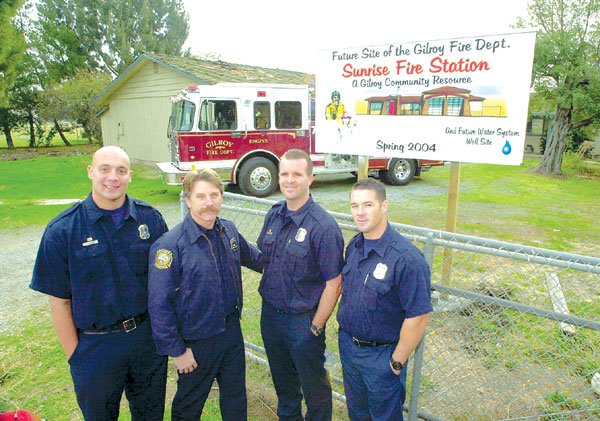GILROY
– With the implementation of the Gilroy Fire Department’s new
paramedic program this month and the construction of Gilroy’s third
fire station on the horizon, fire officials believe the department
will be able to meet the increasingly demanding responsibilities of
ensuring public safety.
GILROY – With the implementation of the Gilroy Fire Department’s new paramedic program this month and the construction of Gilroy’s third fire station on the horizon, fire officials believe the department will be able to meet the increasingly demanding responsibilities of ensuring public safety.
“It used to be that the fire department fought fires and not much else,” said Dave Bozzo, assistant chief with the GFD who has been a firefighter in Gilroy for nearly 30 years. “But now we act as first medical response, cover biohazards, inspect businesses and apartments and basically take care of all public safety except for criminal activity – and that was before 9-11.”
During the last three decades and especially since Sept. 11, 2001, the role of firefighters in Gilroy and across the country has continued evolving. Firefighters of today not only are highly trained in fire prevention and response but also in first aid.
The GFD is hoping that training will net in a safer community when its firefighter/paramedic program starts this month and the new fire station begins operating in July.
“The last time Gilroy got a new fire station, the definition of a firefighter was very different,” said Bozzo, referring to the Las Animas fire station on Wren Avenue that opened in 1976. “You can tell by the new design how much things have changed. The extra square footage is for things we didn’t really have to worry about before – even besides public safety – like providing sleeping quarters for firefighters of different genders.”
When Gilroy’s new fire station at 880 Sunrise Drive is complete in July 2004, it will be home to many of the GFD’s new paramedics. But, in the meantime, the Chestnut Station will begin instituting the city’s firefighter/paramedic program later this month, and by March a firefighter/paramedic will be available to the entire city at all times.
The paramedic or Advanced Life Support (ALS) certification means the firefighters can provide advanced cardiac care, advanced pediatric care and provide advanced drug administration at a trauma scene – all actions that city firefighters with Emergency Medical Technician training cannot do by law.
“This means the first response can administer almost any type of medical assistance needed except surgery,” said Geoff Cady, the GFD analyst.
To become accredited as a paramedic by the Santa Clara County, firefighters must take a six-month long class, work in an emergency room, log a large amount of ambulance ride-along hours and pass a written exam administered by the county.
Six of Gilroy’s 36 firefighters are currently paramedic certified, three are in the late stages of training and two new firefighters/paramedics have been hired within the last month. The department is planning to hire four more paramedic/firefighters within the coming months, bringing its total to 15; only nine are required.
Paramedic certified firefighters earn 11 percent more than Emergency Medical Technician firefighters, and with their 60 hours of college credits their base pay jumps from $59,556 to $66,107.
“The amount of training these guys have is unbelievable,” Bozzo said. “Once we get everyone hired and open the new station, (GFD’s) effectiveness should really increase.”
Not wanting to wait until 2004 to increase that effectiveness, the GFD will begin operating out of a temporary trailer on the new station’s site with a full-time, two-man squad to serve the city’s Northwest Quad in July.
A final review of design plans for the estimated $3.2 million facility will go before the city in January, then a contractor will be selected and construction will begin as early as March.
Site plans for the new station call for an 8,500-square-foot fire station. Gilroy’s two current fire stations, Chestnut and Las Animas, are 6,500 square feet and 5,600 square feet, respectively.
“It was designed before 9-11, but we will be able to use it for new things such as inoculations,” Cady said. “In case of a bio-threat, we would be able to provide vaccines to a large number of people. It makes sense because a fire station is a central location.”
In the case of almost any type of terrorist attack on Americans, the local fire department will be the first line of public safety. Both state and federal agencies are recommending that firefighters already saturated in training learn more about treating potential victims to weapons of mass destruction.
“It seems like we have a full plate already, but we can handle it,” Bozzo said. “We just need the resources.”
To make the fire station as efficient as possible, Cady has been working with the city’s police and fire dispatchers to define the department’s service area.
Utilizing the technology of the city’s new Computer-Aided Dispatch System, Cady is measuring the response times of calls across the city to see how fast an engine from the Sunrise Station would be able to respond to an individual address.
“It is much more of a science now compared to 25 years ago when service areas were simply defined by geography,” Cady said. “We know that travel time on surface streets is what really should define districts.”
With the new station, the city will be divided into three likely response areas by the GFD: south/southeast, which will be covered by the Chestnut Station; central/west, which will be covered by the Las Animas Station; and northwest, which will be covered by the new Sunrise Station. As Gilroy continues to grow, a proposal for a fourth station is expected in the coming years as well.
But with all that has changed in the GFD since Bozzo was a rookie in 1973, and with plenty more to come, he said one thing will always remain the same.
“The bottom line is that we want people to think they are getting their money’s worth for their tax dollar,” Bozzo said. “With technology improvements and the importance of continued specialized training, our goal is to make sure we are prepared to protect the health of the community, and that never changes.”















